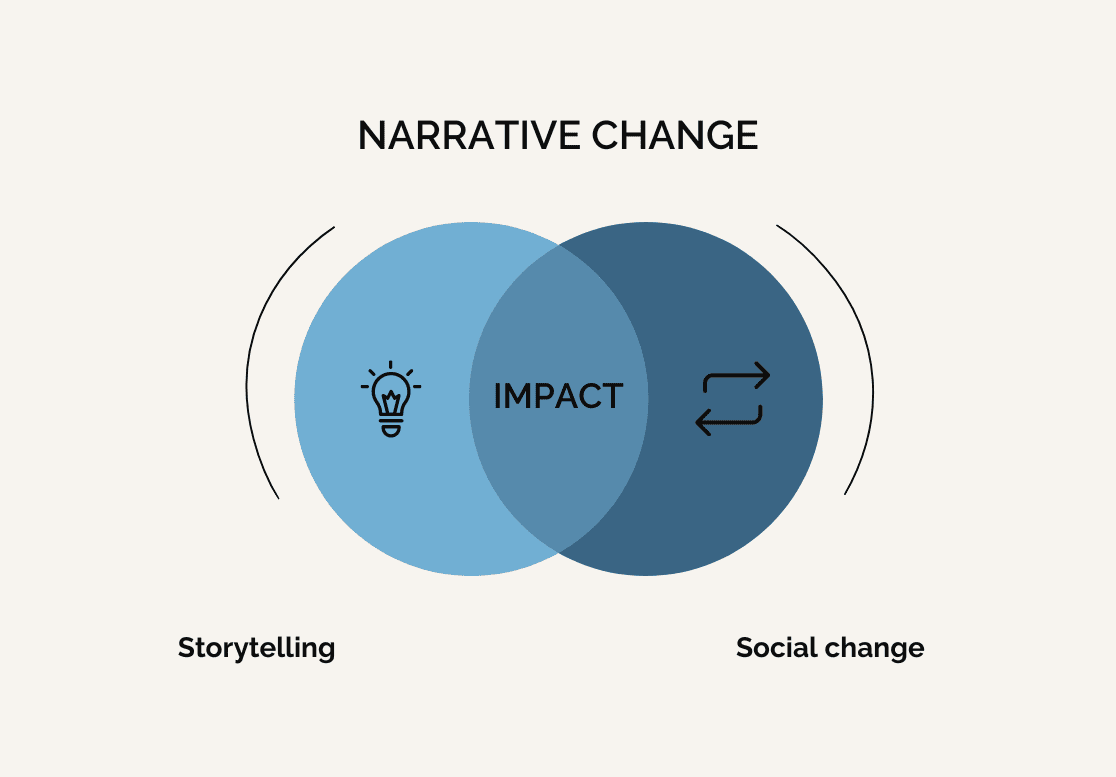Stories hold an extraordinary power — they can captivate, inspire, and, most importantly, transform. In the realm of societal change, it’s not just about spinning tales; it’s about reshaping how we perceive the world. It is about using a variety of storytelling techniques, digital platforms, and community leadership to shape narratives for social change.
Let’s take a journey into the heart of narrative change — read on to learn about our strategies behind effective narrative change.
The art of impactful storytelling
Narrative change strategies and impactful storytelling are at the heart of driving societal transformations. Stories have the unique ability to connect with individuals on an emotional level, making them a potent tool for conveying messages and inspiring change. Whether it’s a social inclusion project advocating for housing equality or a tech company aiming to shift its brand perception, the right narrative can catalyze significant impact.
Narrative transformation begins with the acknowledgment that stories shape our understanding of the world. Effective storytelling techniques are essential in crafting narratives that resonate, prompting the target audiences to rethink their perspectives and take action. Through narrative change, abstract concepts become relatable, compelling individuals to contribute to causes that matter.
Try these! Your new strategies for narrative change
Techniques for effective narrative change involve creating immersive experiences, leveraging personal stories, and employing conflict as a narrative device. Here is a brief overview:
- Immersive Storytelling: Craft stories that envelop the audience, offering them a firsthand experience of the narrative’s impact.
- Data-Driven Narratives: Combine compelling stories with solid data to lend credibility and depth to your message.
- Multi-Platform Engagement: Utilize a mix of digital and traditional platforms to ensure your story reaches a broad audience.
These strategies not only enhance the emotional connection with the audience but also maintain engagement through suspense and challenge preconceived notions. Digital storytelling platforms amplify this impact, allowing for wider dissemination and engagement across various demographics.
Case studies: Successful narrative transformations
Our extensive experience in narrative transformation takes root in impactful initiatives and collaboration with renowned partners. One such example is our Unlock the Cloud campaign with the Eclipse Foundation, aimed at dispelling misconceptions surrounding cloud computing. Through a combination of compelling storytelling, data-driven insights, and multi-platform engagement, we boosted issue recognition, increased policy understanding, and shifted public perceptions toward the adoption of new cloud technology infrastructures.
Another notable success was our partnership with Philips and the United Nations University on the Choose Recycled campaign, tackling the global issue of plastic pollution in the electronics industry. By crafting a narrative centered on the benefits of recycled plastics and the circular economy and leveraging immersive storytelling techniques across various channels, we reached over 10 million media impressions and were featured in over 100 media outlets including BBC, El Mundo, and a number of scientific media.
These case studies highlight the reality of narrative change across diverse sectors. The next section provides several practical tips that will help your campaigns bring impact.

Implementing narrative change: Practical approaches
Reflecting on our work throughout the years, we’ve distilled a set of practical approaches for effective narrative change. These approaches are not only rooted in the diverse projects we’ve undertaken but also serve as educational insights for anyone looking to harness the power of narrative for social impact.
- Culture of Storytelling: Embedding storytelling into the fabric of organizational culture encourages a shared sense of identity and purpose. Our storytelling workshops have proven to bring transformative results by strengthening collective engagement and fostering a vibrant storytelling ecosystem within organizations.
- Community Engagement: Listen to and engage with your communities. Oftentimes, audiences themselves drive organizations towards authentic narratives. Moreover, directly engaging with communities enriches narrative co-creation and ensures the authenticity and relevance of the narratives produced.
- Strategic Advocacy: Utilizing storytelling for advocacy allows for the humanization of critical issues, making them more relatable and compelling to the audience. One of your approaches could be blending personal experiences with scientific data — encouraging public action and policy advocacy via emotionally engaging and, at the same time, informative strategic messages.
- Trends Monitoring and Data Analysis: The use of data analytics and trends monitoring to refine storytelling strategies is crucial for maximizing impact. Just like that, you can use cultural insights to captivate the target audiences and further adjust the roll-out via engagement metrics analysis, optimizing the narrative impact on the go.
These approaches serve as pillars for fostering engagement, inspiring action, and driving narrative change, ultimately contributing to creating a more equitable and inclusive society.
Reinforcing narrative transformation
To ensure impactful narrative transformation, it is vital to sustain the momentum of change.
This involves continuous engagement, integrating effective storytelling techniques, and reinforcing the narrative’s core message. By cultivating a storytelling culture and leveraging leadership, organizations can maintain their relevance and continue to inspire action.
Are you ready to wield the power of storytelling to create a better world?
Get in touch today, share your story, and let’s make change happen.



